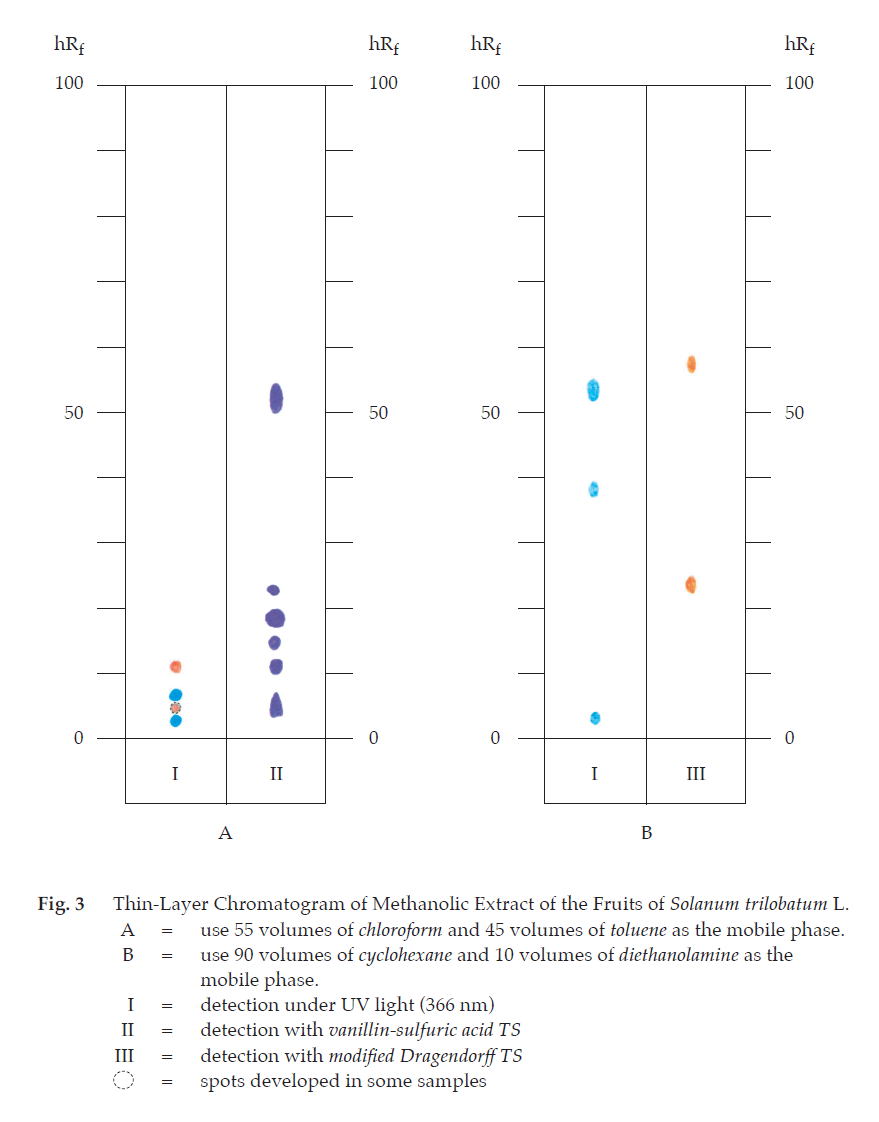ตำรามาตรฐานยาสมุนไพรไทย
Thai Herbal Pharmacopoeia
สำนักยาและวัตถุเสพติด กรมวิทยาศาสตร์การแพทย์ กระทรวงสาธารณสุข
Bureau of Drug and Narcotic, Department of Medical Sciences, Ministry of Public Health(Tinospora crispa (L.) Hook.f. & Thomson)
(Nelumbo nucifera Gaertn.)
(Centella asiatica (L.) Urb.)
(Centella Dry Extract)
(Centella Cream)
(Mesua ferrea L.)
(Piper sarmentosum Roxb.)
(Piper sarmentosum Roxb.)
(Pterocarpus santalinus L. f.)
(Santalum album L.)
(Senna tora (L.) Roxb.)
(Senna alata (L.) Roxb.)
(Senna Alata Tea)
(Piper retrofractum Vahl)
(Myristica fragrans Houtt)
(Andrographis paniculata (Burm. f.) Nees)
(Andrographis Capsules)
(Allium ascalonicum L.)
(Ocimum tenuiflorum L.)
(Curcuma longa L.)
(Turmeric Capsules)
(Turmeric Dry Extract)
(Turmeric Dry Extract Capsules)
(Arcangelisia flava (L.) Merr.)
(Curcuma sp.)
Harrisonia perforata (Blanco) Merr.
(Aristolochia pierrei Lecomte)
(Zingiber officinale Roscoe)
(Ginger Capsules)
(Ginger Tea)
(Cassia fistula L.)
(Nardostachys jatamansi (D. Don) DC.)
(Angelica sinensis (Oliv.) Diels)
Artemisia annua L.
(Ligusticum sinense Oliv. cv. Chuanxiong)
(Neopicrorhiza scrophulariiflora Pennell)
(Atractylodes lancea (Thunb.) DC.)
(Aucklandia lappa Decne)
(Terminalia chebula Retz.)
(Angelica dahurica (Hoffm.) Benth. & Hook. f. ex Franch. & Sav. var. dahurica)
(Kaempferia parviflora Wall. ex Baker)
(Hibiscus sabdariffa L.)
(Roselle Tea)
(Allium sativum L.)
(Zingiber zerumbet (L.) Sm.)
(Wurfbainia testacea (Ridl.) Škorničk.& A. D. Poulsen)
(Cannabis sativa L.)
(Myristica fragrans Houtt)
(Dracaena cochinchinensis (Lour.) S. C. Chen)
(Ficus racemosa L.)
(Hyptis suaveolens (L.) Poit.)
Clerodendrum indicum (L.) Kuntze
(Phyllanthus emblica L.)
(Citrus hystrix DC.)
(Citrus hystrix DC.)
(Areca catechu L.)
(Momordica charantia L.)
Moringa oleifera Lam.
(Aegle marmelos (L.) Corrêa)
(Solanum trilobatum L.)
(Morus alba L.)
Gynostemma pentaphyllum(Thunb.)
Makino
(Clinacanthus nutans (Burm. f.) Lindau)
(Cissus quadrangularis L.)
(Mimusops elengi L.)
(Zingiber montanum (J. König) Link. ex A. Dietr.)
(Piper betle L.)
(Capsicum annuum L.)
(Capsicum Oleoresin)
(Capsicum Gel)
(Piper nigrum L.)
(Piper nigrum L.)
(Eurycoma longifolia Jack)
(Thunbergia laurifolia Lindl.)
(Piper wallichii (Miq.) Hand.-Mazz.)
Senna garrettiana (Craib) H. S. Irwin & Barneby
(Terminalia bellirica (Gaertn.) Roxb.)
(Terminalia chebula Retz.)
(Caesalpinia bonduc (L.) H. Roxb.)
(Tarlmounia elliptica (DC.) H. Rob., S. C. Keeley, Skvaria & R. Chan)
(Hog Creeper Vine Dry Extract Capsiles)
(Hog Creeper Vine Dry Extract)
(Brachypterum scandens (Roxb.) Miq.)
(Lepidium sativum L.)
(Nigella sativa L.)
(Cuminum cyminum L.)
(Foeniculum vulgare Mill.)
(Plantago ovata Forssk.)
(Pimpinella anisum L.)
(Carum carvi L.)
(Anethum graveolens L.)
(Trachyspermum ammi (L.) Sprague)
Albizia procera (Roxb.) Benth.
(Acorus calamus L.)
(Tiliacora triandra (Colebr.) Diels)
Cyanthillium cinereum (L.) H. Rob.
(Orthosiphon aristatus (Blume) Miq.)
Murdannia loriformis (Hassk.) R. S. Rao & Kammathy
(Capparis micracantha DC.)
(Chrysopogon zizanioides (L.) Roberty)
(Cyperus rotundus L.)
(Cannabis sativa L.)
(Syzygium aromaticum (L.) Merr. & L. M. Perry)
(Boesenbergia rotunda (L.) Mansf.)
(Acanthus ebracteatus Vahl)
(Acanthus ilicifolius L.)
(Kaempferia galanga L.)
(Curcuma comosa Roxb.)
Betula alnoides Buch.-Ham. ex D. Don
Cannabis sativa L.
Carthamus tinctorius L
Mitragyna speciosa (Korth.) Havil
Mallotus repandus (Rottler) Müll. Arg
Azadirachta indica A. Juss. var. siamensis Valeton
Azadirachta indica A. Juss. var. siamensis Valeton
Punica granatum L.
Rhinacanthus nasutus (L.) Kurz
Baliospermum solanifolium (Burm.) Suresh
Curcuma aeruginosa Roxb
Boesenbergia kingii Mood & L. M. Prince
Senegalia rugata (Lam.) Britton & Rose
Acacia concinna (Willd.) DC.
Senegalia rugata (Lam.) Britton & Rose
Acacia concinna (Willd.) DC.
Senna alexandriana Mill. var. alexandriana
Cassia acutifolia Delile, Cassia angustifolia Vahl
Butea superba Roxb. ex Willd.
[Plaso superba (Roxb. ex Willd.) Kuntze, Rudolphia superba (Roxb. ex Willd.) Poir.
Pueraria candollei Graham
ex Benth. var. mirifica (Airy Shaw & Suvat.) Niyomdham
Streblus asper Lour.
Suregada multiflora (A. Juss.) Baill. (Gelonium
multiflorum A. Juss.
Solanum Trilobatum Fruit is the dried green mature fruit of Solanum trilobatum L. (Family Solanaceae), Herbarium Specimen Number: DMSC 147, 163, Crude Drug Number: DMSc 1019.
Constituents Solanum Trilobatum Fruit contains solasodine.
Description of the plant (Figs. 1a, 1b) Slender scrambling shrub up to 3.6 m long; prickles hooked, broad-based, yellowish and numerous along the stem, otherwise almost glabrous; branches long divaricate, the young ones sometimes with a few stellate hairs, the older glabrous. Leaves simple, alternate, ovate or rotund-ovate, 2 to 7 cm long, 1 to 4 cm wide, obtuse, irregularly sinuate or 3- to 5-lobed, sparsely stellately hairy or glabrous; petiole and midrib with or without a few prickles, 1.3 to 3.8 cm long, base broadly cuneate-truncate, sometimes unequal. Inflorescence extra-axillary racemose cyme; peduncle short, 3- to 9-flowered. Flower showy, violet-purple; pedicel 1 to 2 cm long, widely divergent, often prickly; calyx cyathiform, 3 to 4 mm long with narrow teeth, sparsely stellately hairy; corolla 1.2 to 1.6 cm long, tube 2 mm long, deeply lobed, stellate-pubescent outside, usually reflexed; stamen protruding, anther 7 mm long, narrowly oblong, yellow, filament 1.2 mm long; ovary 2-celled, ovoid or subglobose, style glabrous. Fruit berry, globose, about 1 cm in diameter, mature berry green with white mottling, scarlet when ripe. Seeds numerous, compressed, 3 mm in diameter, slightly pitted.
Description
Macroscopical (Fig. 1a) Nearly globular, from 6 to 10 mm in diameter, externally light brown to dark brown, more or less wrinkled. The base marked by a circular stalk scar, about 1 mm in diameter.
Microscopical (Figs. 2a, 2b) Transverse section of the fruit shows epidermis, a single layer of rectangular cells with cutinized outer walls. Hypodermis, 1 to 2 layers of rectangular cells. Two zones of parenchyma cells, the outer composed of 6 to 9 layers of thick-walled, polygonal cells containing chloroplastids, the inner composed of more layers of larger and thin-walled cells containing mucilage and numerous starch grains and small vascular bundles are scattered in this region. Epidermis of seed coat, a single layer of large lignified sclereids, more or less columnar-shaped, inner walls are thicker with irregularly flamelike thickened appendages. Endosperm, small thin-walled, polygonal parenchyma cells containing oil droplets. Cotyledon, several layers of small polygonal cells containing oil droplets.
Solanum Trilobatum Fruit in powder possesses the diagnostic microscopical characters of the unground drug.
Packaging and storage Solanum Trilobatum Fruit shall be kept in well-closed containers, protected from light, and stored in a dry place.
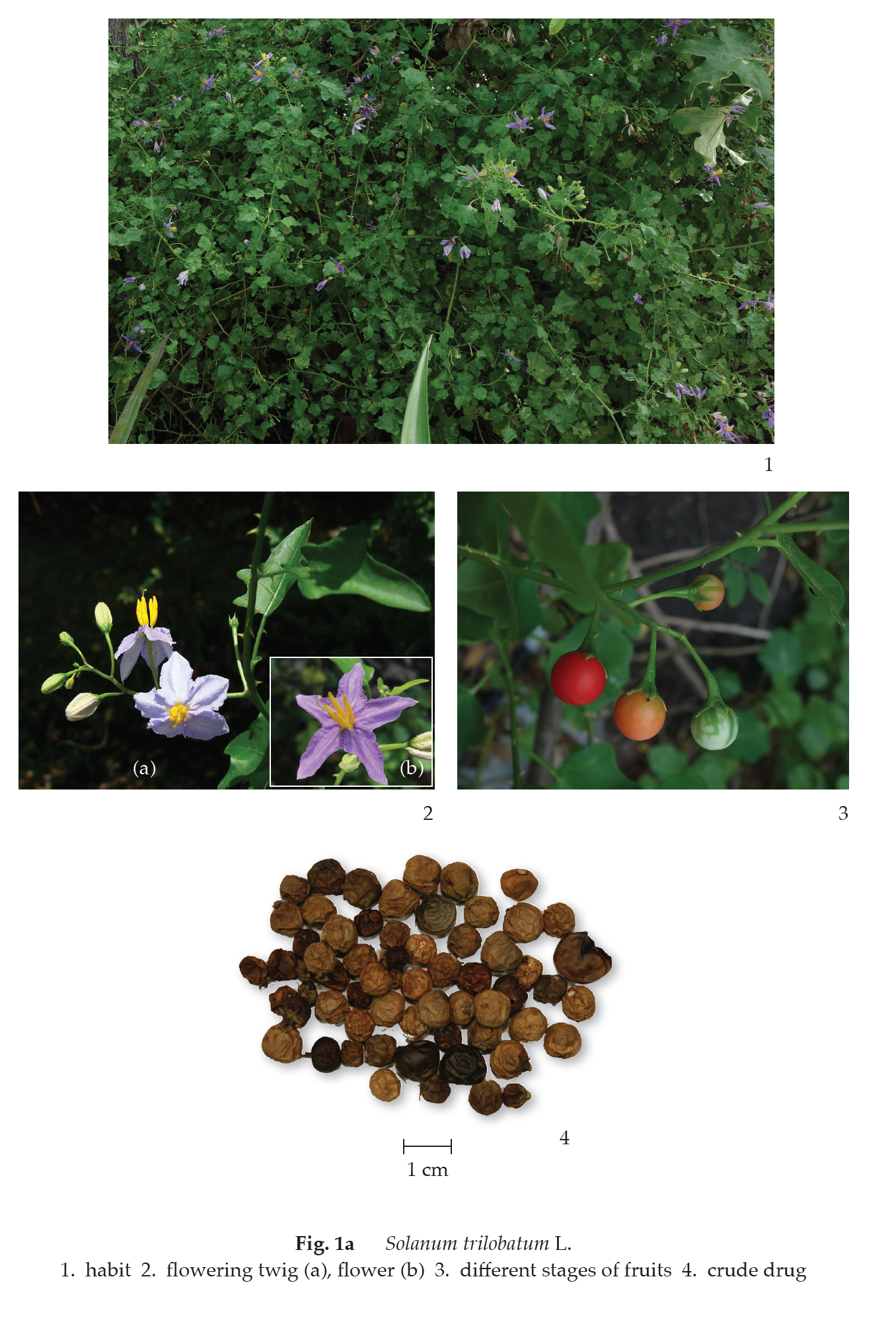
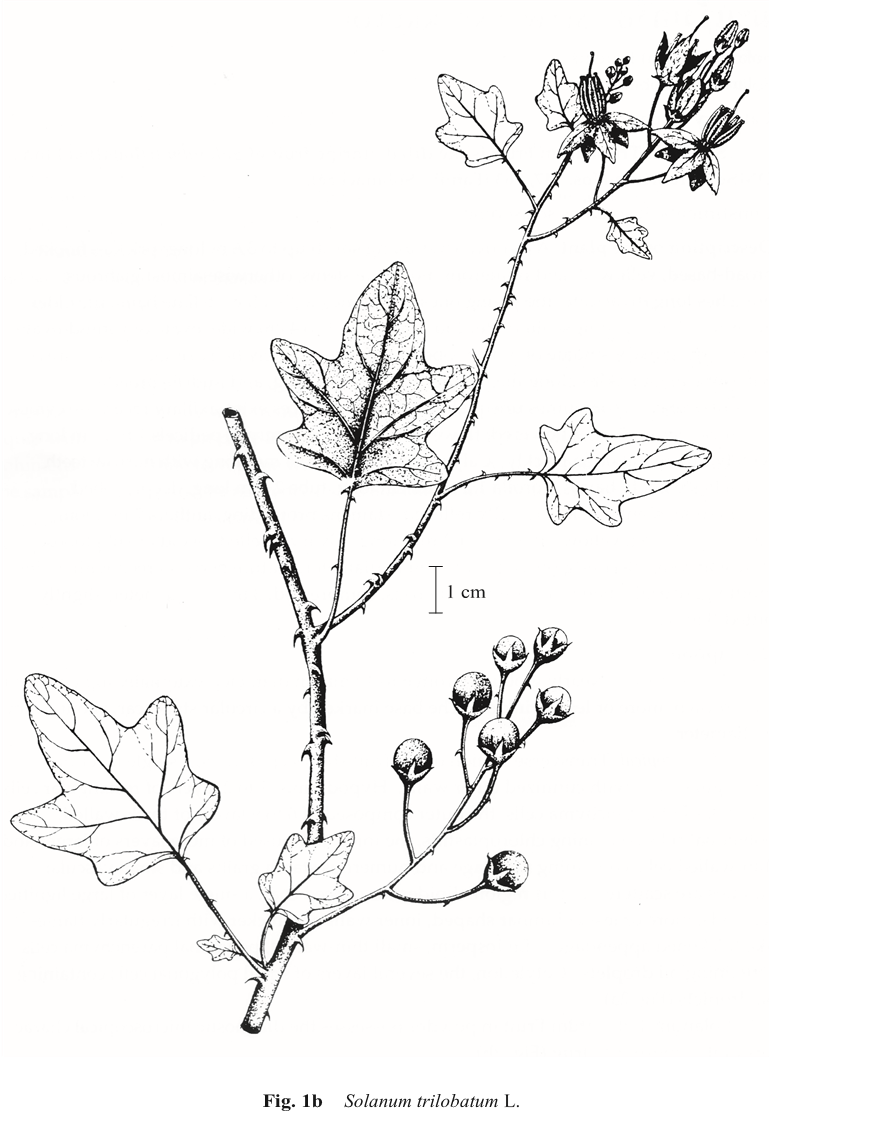
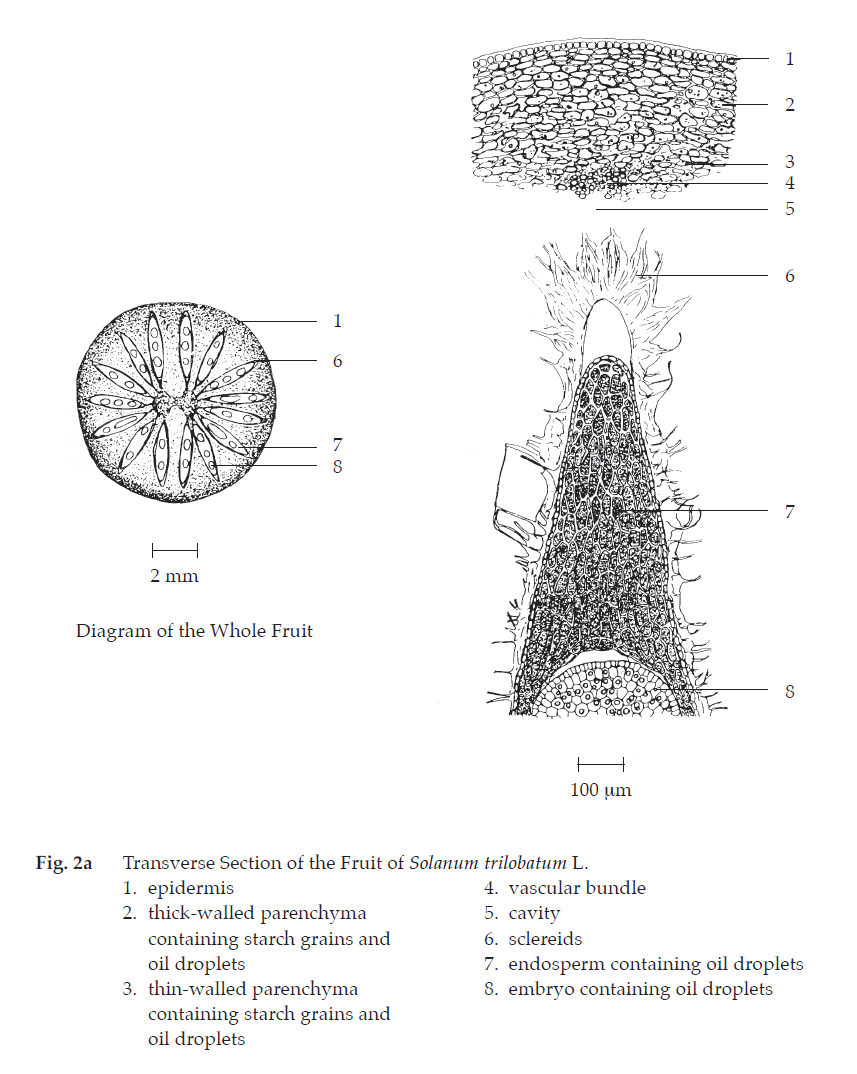
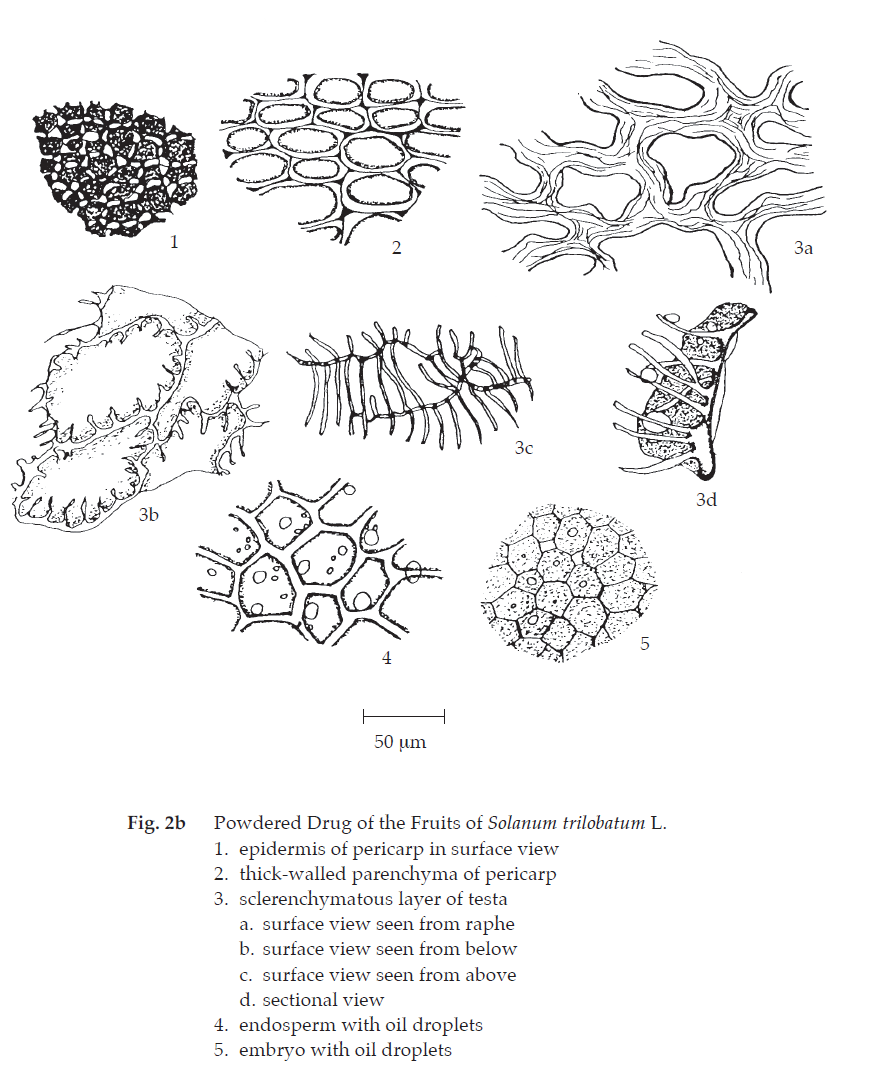
Identification
A. Reflux 500 mg of the sample, in powder, with 10 mL of ethanol for 30 minutes, and filter. Evaporate 2 to 3 mL of the filtrate to dryness and add 2 to 3 drops of acetic anhydride and a few drops of sulfuric acid: a violet colour is produced.
B. Carry out the test as described in the “Thin-Layer Chromatography” (Appendix 3.1), using silica gel G as the coating substance and a mixture of 55 volumes of chloroform and 45 volumes of toluene as the mobile phase. Apply to the plate, 10 μL of the test solution prepared by refluxing 5 g of the sample, in powder, with 10 mL of methanol for 20 minutes, and filtering. After removal of the plate, allow it to dry in air and examine under ultraviolet light (366 nm); two blue and two red fluorescent spots appear. Spray the plate with vanillin-sulfuric acid TS and heat at 120° for 5 to 10 minutes; six violet spots are observed (Table 1); see also Fig. 3.
Repeat the same procedure on another plate but using 90 volumes of cyclohexane and 10 volumes of diethanolamine as the mobile phase. After removal of the plate, allow it to dry in air and examine under ultraviolet light (366 nm); three blue fluorescent spots appear. Spray the plate with modified Dragendorff TS; two orange-yellow spots are observed (Table 1); see also Fig. 3.

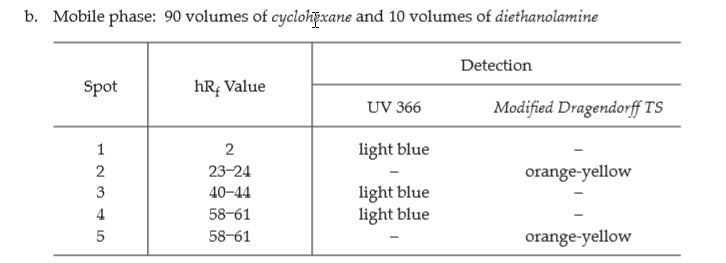
Loss on drying Not more than 6.0 per cent w/w after drying at 100° to constant weight (Appendix 4.15).
Acid-insoluble ash Not more than 1.0 per cent w/w (Appendix 7.6).
Sulfated ash Not more than 11.0 per cent w/w (Appendix 5.3).
Ethanol-soluble extractive Not less than 3.0 per cent w/w (Appendix 7.12).
Water-soluble extractive Not less than 5.0 per cent w/w (Appendix 7.12).
Chloroform-soluble extractive Not less than 1.0 per cent w/w (Appendix 7.12H).
